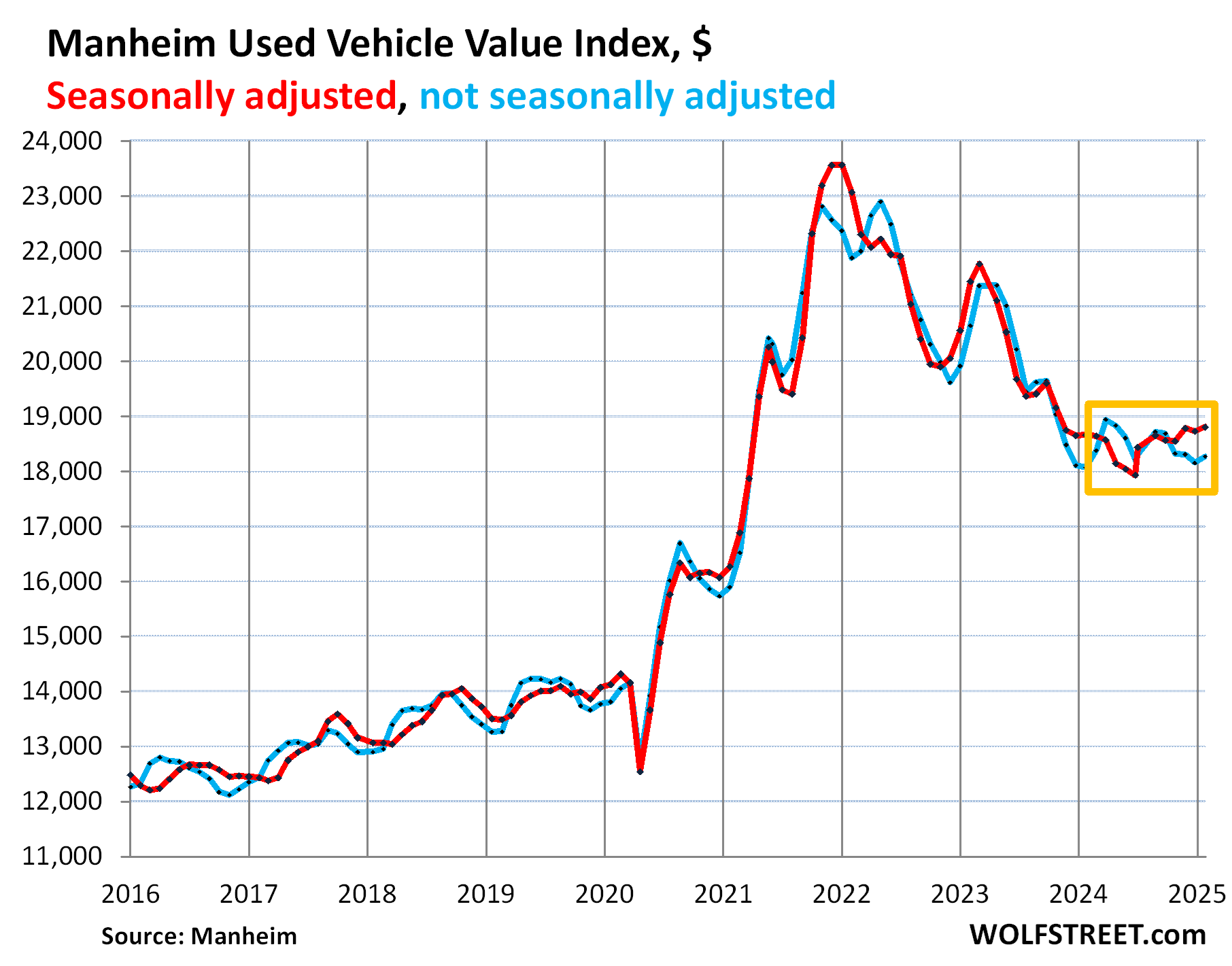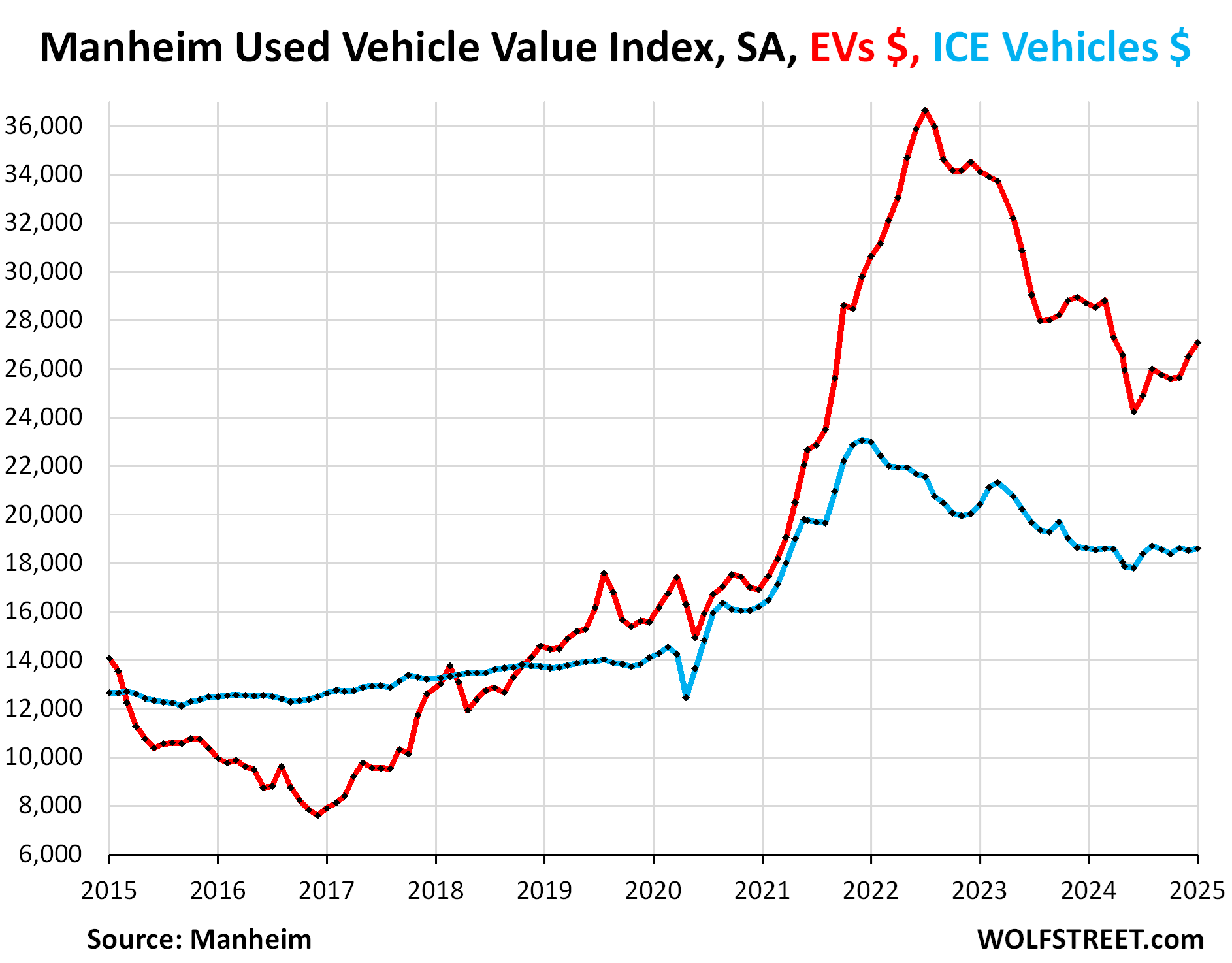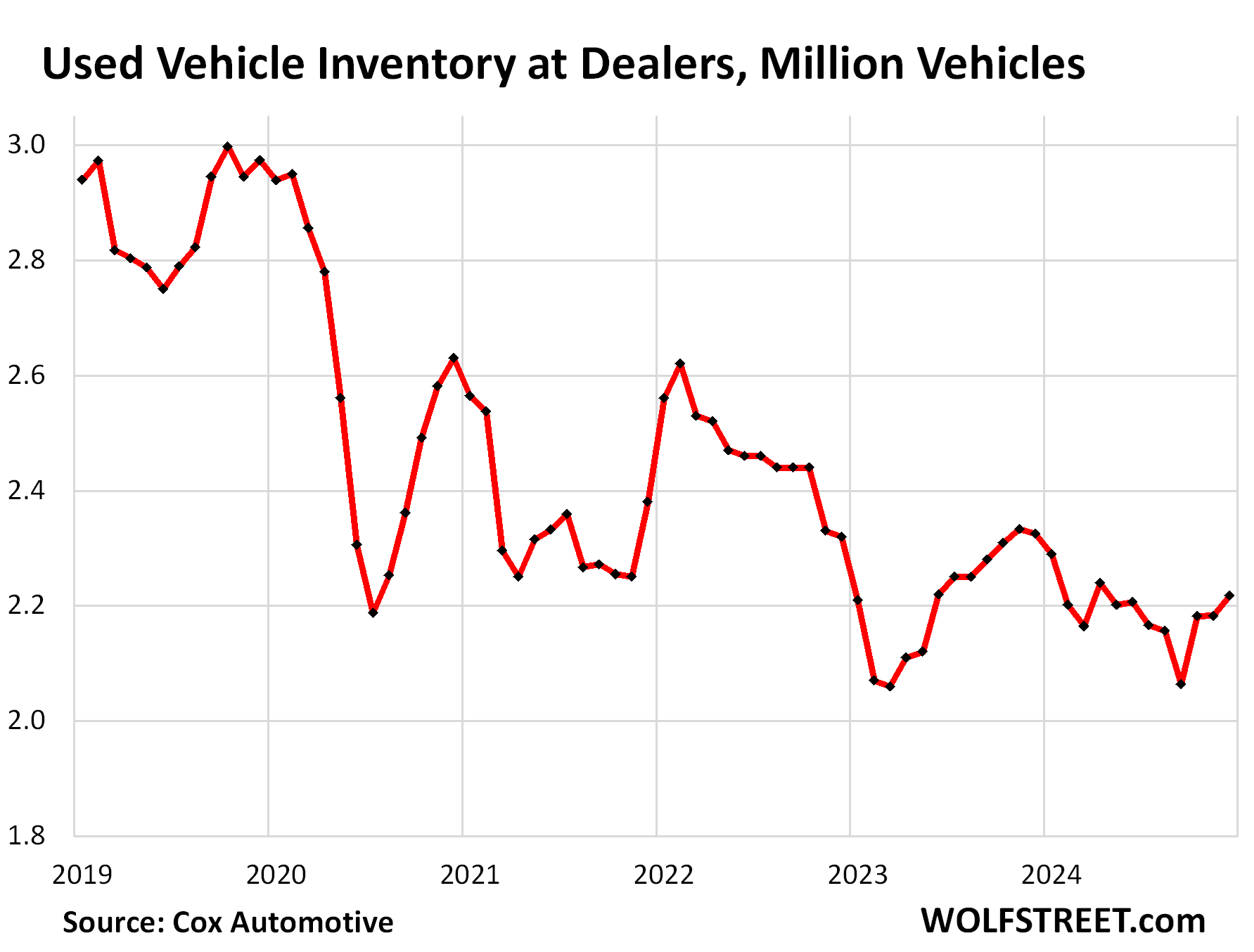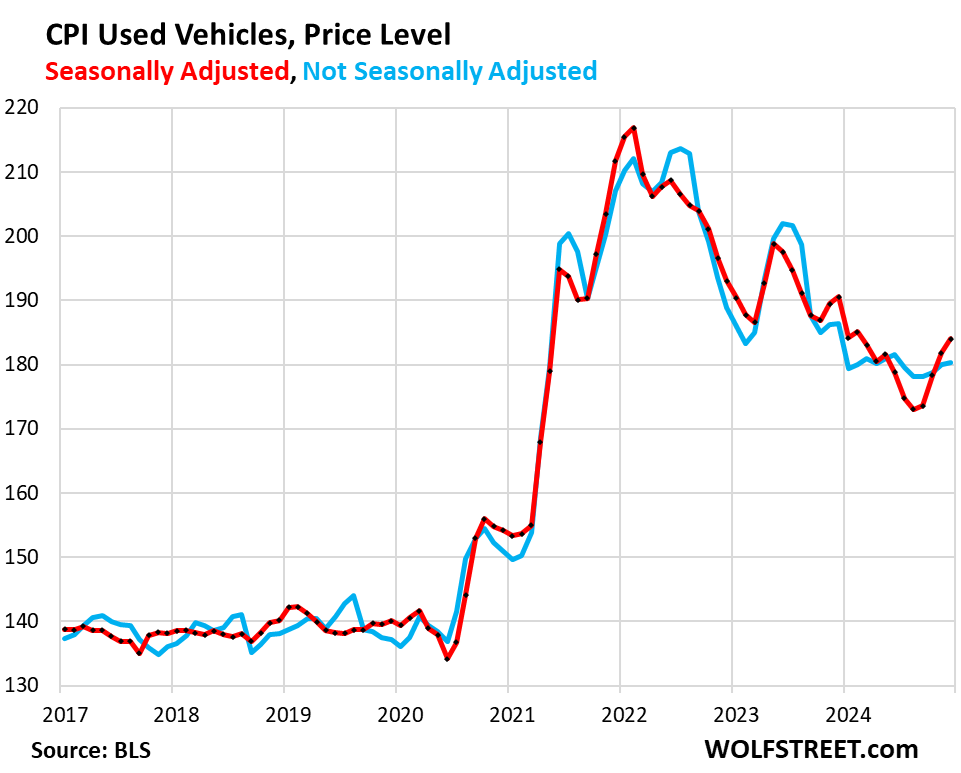Already putting pressure on CPI inflation. Now comes tax-refund season.
By Wolf Richter for WOLF STREET.
Inflation pressures are rebuilding in used vehicles. Prices of used vehicles sold at auctions where franchised and independent dealers replenish their inventories rose by 0.4% in January from December, seasonally adjusted (red line), and by 0.6% not seasonally adjusted (blue line), according to the Used Vehicle Value Index by Manheim, the largest auto auction house in the US. The index is adjusted for changes in mix and mileage.
Since the low point in June, prices have risen by 4.9%, seasonally adjusted, and are at the highest level since October 2023. “While it’s not yet spring, wholesale values increased more than we usually see in the month of January, with particular strength at the end of the month,” Manheim said.
Supply at these auctions comes from rental fleets that sell vehicles they pulled out of service, from finance companies that sell their off-lease vehicles and repos, from corporate and government fleets, other dealers, etc. These prices are the costs for dealers, and prices that consumers pay, as tracked by the used-vehicle CPI, follow with some lag.

What’s coming now is tax-refund season, which is peak selling season for used vehicles as tax refunds make great down payments. During those months, demand surges, and prices rise, and the whole industry is licking its chops. But inventories are tight this year. And even if it’s just the typical surge in tax-refund-season demand, it will put further upward pressure on prices.
But demand is already starting out hot. Used-vehicle retail sales in January were up by 15% year-over-year, according to preliminary estimates from Cox Automotive.
Price increases by power train.
Prices of used EVs jumped by 2.1% in January from December, and by 11.7% since the low point in June, seasonally adjusted, to an index price of $27,086. EV prices are still 74% higher than in December 2019, after the horrendous 127% spike during the pandemic (red in the chart below).
Prices of used vehicles with internal combustion engines (ICE) rose by 0.4% in January from December, and by 4.5% from the low point in June, to $18,602. Prices are 32% higher than in December 2019 (blue).
EVs are still a small but rapidly growing segment of what’s going through auctions, supplied mostly by rental fleets and lease returns. And it’s not just Teslas anymore, but numerous different models by other automakers.
In California, the largest auto market and EV market in the US, sales of new EVs rose to a record share of 22% of total new vehicle sales in 2024. In Q4, sales of new non-Tesla EVs surpassed Tesla sales for the first time. This is the feedstock for supplying the used-vehicle market, and it has been building momentum for years.

Used-vehicle wholesale prices had exploded by 65% in 2020-2021, according to Manheim, a unit of Cox Automotive. Retail prices had spiked by 55%, according to CPI data. This historic spike had been a substantial contributor to inflation over this period. Then prices plunged in 2022 through 2023, surrendering about half of the wholesale price spike and about a third of the retail price spike, thereby contributing to the sharp deflation in durable goods that helped decelerate overall inflation. But those used-vehicle price declines stopped in 2024 and reversed course.
The inventory issue.
Retail inventories are tight amid supply issues and solid demand. The inventory at the end of December at used-vehicle dealers was at about 2.2 million units, down by about 5% from the already low levels a year ago, and down by 25% from December 2019.
But in January, sales jumped 15% year over year, and supply fell during the month, according to preliminary estimates from Cox Automotive.

New influx into the used vehicle market comes from vehicles that had been purchased new some time ago. They enter the used market via trade-ins, lease returns, fleet turnover such as at rental operations (2.5 to 3.5 million vehicles in a normal year), etc.
The problem now is that during the period of the semiconductor shortages in 2021 and 2022, global vehicle production plunged. In the US, 6 to 10 million fewer new-vehicles were sold over the two-year period than might have been otherwise, and these 6-10 million vehicles are now missing from the national fleet, and they’re now not entering the supply pipeline of used vehicles.
In addition, leasing activity in 2021 and 2022 plunged, and so the number of leases that are now maturing is way down, and so supply from leasing companies, when they sell the two and three-year-old off-lease vehicles at auctions, has plunged. This will drag into 2026. And if demand remains solid amid this tight inventory, prices will feel the heat.
Retail prices U-turned.
Retail prices, as measured by the CPI for used vehicles, lag these whole sale prices by a couple of months, and hit their low point in August (auction prices hit the low point in June).
The used vehicle CPI jumped by 1.2% in December from November, seasonally adjusted, the fourth month-to-month increase in a row. From the low point in August through December, the index has jumped by 6.4%, a substantial increase (red).
The CPI for January will be released on February 12 and will be captured in our series, Beneath the Skin of CPI Inflation.
We pay a lot of attention to this because the 20% plunge of used vehicle retail prices from early 2022 through August 2024 was a powerful factor in the cooling of CPI inflation. But that trend has U-turned.

Enjoy reading WOLF STREET and want to support it? You can donate. I appreciate it immensely. Click on the mug to find out how:
![]()


Unfortunate I feel, as used auto prices are still expensive for many. I’d love to get into an EV soon, so I’m glad their sales are increasing, thus I’ll try to get a lease or fleet rental return sooner than later. he in the bay area utilities are crazy, crazy ridiculously expensive, it really doesn’t make sense for me to get Solar, just yet putting down 40,000 for unused solar system gives me about a roi in 24 yrs it’s the gas prices here which are criminal hitting my house up monthly during the winter is about 850 bucks a month with gas, thank you Pacific gas and electric from Redwood City.
looking to put my 2016 F350 truck as down payment on house
/ income property
did that with F150 3 years ago – seller really needed decent vehicle
then I should get my ‘value’ v. BS kbb ones
won’t take less
I’ll keep = still pulls 8 ton trailer every summer
VERY glad to see this reporting from Wolf,,,
Just had the absolutely wonderful pleasure of the pick up of the 2003 Buick LeSabre LTD being by the transporter to take that car to my grand daughter.
Bought it at blue book, then ”fixed it” to my standards to at least try to bring it to my son’s standards,,,
SO much ”more better” to give to her than to ”sell”…
I want to encourage all y’all to do the same for your ”GRANDS” as soon as you can figure out how to do so….
Vintage VNvet-
Way to go. Every time I look at used cars on Craigslist etc., I always start by entering “2003”. 22 years and counting on my 2003 Honda CRV.
A buddy recently bought and is fixing up a 2005 Buick Rainier… car has some interesting features like a built-in compressor and air suspension in the rear.
If you’re spending 40k on a solar system, you’re getting ripped off. That was the price 10 years ago. The cost of panels and batteries have dropped significantly.
We bought a new 8.820 kWhr system from Solar City in 2010 for $24K cash… and costs have only dropped since. Perhaps the $40,000 includes batteries(?)
Wolf, our used car inventory is so low right now. I tell people if they want a certain car they better buy it now because it will be gone. They often don’t believe me, sigh. Then they call back later and I have to inform them it’s sold!
Even in the cheap car range, dealers are bidding prices up.
You’ll see green alligators and long necked geese,
Some humpty-back camels and some chimpanzees,
A cat, a rat, and maybe even a Wolf in the Street,
But ya ain’t gonna find a cheap used car fleet.
I think I see a rat.
In 2017 I bought a used Ford Taurus with 83,000 miles for $2000. I’m still driving it. You have to be an idiot to pay such high prices for a used car.
I’ll wait for the next used car glut to buy another car. I’m certainly not interested in buying a new car, as prices have skyrocketed, along with insurance premiums.
I also have the option ditching my car altogether, and using public transportation. It would be a sacrifice, but I would save a ton of money.
I’m still watching that ridiculously overvalued bubble stock Carvana which is going to collapse like a house of cards. It already happened once, it will happen again.
I agree. I drive an old BMW that I bought for $1500. It’s been a great car. Carvana is nuts. They are paying $3-4k over our trade in offers. Just sent a customer their way to buy their car. I don’t know how v they make an actual money on their cars. Must be all be in the financing.
What model and year BMW did you buy for $1500? What is the mileage on it?
2001 E39 Bmw 525i with 150k. Single owner in great condition. BMW inline 6 cylinders are super reliable and will go 300-400k with proper maintenance. It helps if you like to work on your own car. One of the best automobiles ever made.
I also have an E39 in the 540i version produced in 1997 and it only has about 66,600 miles on it and is gorgeous in Oxford Green over Sand Beige. Yes, the E39 models are the among the very best BMW has ever done. You got an incredibly excellent deal if you got it for only $1,500! Enjoy!
Idontneedmuch,
I agree that used (perhaps especially *old* used) is likely the way to go.
But how do you avoid the “terminal clunker” risk – the possibility that you are buying something truly on its last legs, soon to turn into inert metal – flushing (lower) thousands away?
I know you can have mechanical pre-inspections done – but it isn’t like those mechanics are going to provide any kind of warranty/guarantee.
I agree that starting out thinking that 7k for a used car makes a helluva lot more sense than starting at 16k+ – but the terminal clunker risk always unnerves me. A non-operating car (even at $7k – is worthless).
I would be interested in hearing other people’s risk-mitigation strategies for addressing this problem.
@cas127 try to buy cars from original owners who have all the records and are looking to get just a little more than they were offered at trade in. Like a lot of people my Uncle gets a new Toyota Camary every five years when they are getting close to 100K miles. It is embarasing how little the dealers always offer him for his perfect always garaged old car (so signs the title and I sell them on Criagslist for thousands more)
Adding to what ApartmentInvestor said:
Try to buy cars from the inland south. Less exposure to both road salt and salty sea spray.
Rust is cancer.
Or just low overhead. No dealers commission. No expensive lot costs. Not my niche, but buddy of mine was salesman and got out 4-5 years ago, telling me current sales model is dieing. That most buyers already do 98% of their research and shopping online. If we were only some trust funders, could have got in on it early…
Is there a list of twice-imploded stocks?
Well they just had their first profitable quarter ever. I don’t think car vending machines are low overhead. But it seems like they are starting to turn it around. But I don’t trust them. I wish 98% of buyers were educated. It would sure make my job easier. It doesn’t seem that way on front line.
They are riding the biggest everything bubble in history. Until this thing pops, businesses which have no business being in business, can exist or even somewhat prosper.
2011 Acura RDX. 193K miles.
Just spent this beautiful afternoon adding a heat shield to the intake ducting and replacing mesh screens in the hood scoop (they reduce road debris getting sucked in and damaging the intercooler). Also replaced some of the the boost reference line hoses.
New car? No thanks.
‘If’ there is a tax refund season. Since Covid refunds have been super delayed. And now if they cut into IRS staffing the season will be even more spread out
“‘If’ there is a tax refund season.”
I’m confident there are still plenty of people willing to give the Treasury an interest-free loan.
Not quite the line I’m taking..nm.
Most refunds are automated, they’d have to unplug the machines, which would be an intriguing way of cutting the deficit: just cancel all tax refunds and tax credits, LOL
Cancel all the refunds yay.
Haven’t received a refund in almost 25 years All these people give the gov free loans and call the excess a refund always made me laugh.
Two caveats: if they would have spent the money instead of paying too much tax and receiving a refund, they’d be worse off; and during ZIRP there was very little interest to collect or forego.
LOL having done taxes at JH tax service for years for my sister in Texas who owns 9 franchises north of Austin. Her business is booming and growing every year. Online is not competing with her business at all. People find that tax services that offer “interest free loans” instant refunds onto a credit card etc lets them buy those used cars quicker!!
End of February is when the IRS opens for business for the earned income credit and child tax credit payments!! Get in line if you earn something below 18-20K the earned income credits and dependent credits can really add up!! Especially for a single person who is head of household.
I would encourage everyone to file a tax return free with the IRS if they qualify because by filing free and early your SS number gets locked down by IRS and eliminates potential fraud.
How many % people still file paper returns? Does that clog up the system?
Paper returns are scanned and entered automatically and dealt with automatically. Printed returns are a breeze for scanners. Hand-writing scanning has gotten very good too. And they’re handled automatically too. If there are problems, the return will be routed to a human. State income tax returns are the same way.
Ride my bicycle. It’s easier to park.
Bicycles and their riders don’t do well in blizzards and monsoons.
cars don’t either. Better stay home.
Hell no, the Prairie Rider ain’t staying home.
Shit, I got me a pair of 40 mm wide tungsten-carbide studded winter tires on my OTSO (from Wolf Tooth Components, Burnsville, Minnesota) gravel bike.
Minneapolis had 5+ inches of snow yesterday. Today’s forecast at noon? It will be sunny & 13 F. A beauty of a day for a ride, eh?
P. S. Wolf, the cross-country ski trails along the Mississippi and on the river’s shoreline will be perfect today!
Prairie Rider,
“the cross-country ski trails along the Mississippi and on the river’s shoreline will be perfect today!”
When we skate-ski up a long slope at 7,000-plus feet altitude, after having come up from sea level with no time to acclimatize (as we did a couple of weeks ago), I always dream of skiing near sea level where oxygen is thick and overabundant.
But we wouldn’t ski in a blizzard either, and I don’t think you would ride your gravel bike in a blizzard either. You’d wait till the sun comes out and then have a glory day for all times to come.
Fall/spring riding was always easier than summer… you’re not arriving at work drenched in sweat!
Wolf,
Yes, there are times when it is wise to stay home. And you’re right, I do not ride my gravel bike in a blizzard.
Live in sunny south Florida never any inclement weather… heh.
And easier to steal – ask me how I know, unless the car is a Hyundai or Kia.
From my perspective only very wealthy people can afford to ride their bicycles to work
I like really nice cars that have been well maintained.
It’s possible to buy future classics at that age the they are fully depreciated and about to start appreciating. I have been doing it for 40 years and have put together a nice collection after driving them for a few fun years. Some have appreciated spectacularly and only required by the book maintenance. Others have only appreciated modestly.
The trick is finding highly optioned, low mile versions of popular sports cars.
@Frosty unlike with a stock every well maintained well running car will eventually start going up in value (thanks in part to inflation), but market timing the car market is as hard as it is with the stock market. I’ve sold some cars for more but most I have sold for less. My 1997 D90 has gone up in value, but that is mainly because it sits in the garage at the cabin on a battery tender most of the time. I bought my 997.2 Cabrio (that I drive almost every day it is not raining) from a fellow (more OCD than me) PCA member with just over 30K miles but it will sell for less when I hit 150K miles and sell it in a couple years.
My local garage published its annual Christmas letter and in it they said that the cars that they are now fixing are much older than they were before so when they put them on the hoist, they find more things wrong then what the car went in for. They apologized for any delays from this. The takeaway is people are keeping cars longer because they cannot afford $35,000 for an entry-level Honda civic. The used car repair market seems to be soaring!
There were 16 million new vehicles sold in 2024. But there are 6-10 million fewer 2021-2022 vehicles in the national fleet due to the production cuts, and those 6-10 million vehicles are no missing.
The OEMs refer to that as PARC.
I like really nice cars that have been well maintained.
It’s possible to buy future classics at that age where they are fully depreciated and about to start appreciating. I have been doing it for 40 years and have put together a nice collection after driving them for a few fun years. Some have appreciated spectacularly and only required by the book maintenance. Others have only appreciated modestly.
The trick is finding highly optioned, low mile versions of popular sports cars.
Why highly optioned, since the price premium the original owner paid will make it much harder for you to beat him down on price when you buy from him?
I can definitely see a market for flipped, used sports cars (which are pretty darn rare new these days) but I always thought the morass of optioning packages only really served the interests of the manufacturers and (especially) the original selling dealers – who I perceive use the array of option packages to confuse the hell out of buyers while absurdly up-charging them on things with small true incremental production costs.
But I’m open to hearing otherwise.
No thanks to a 4 cylinder as the foundation power source boosted by a turbocharger + supercharger + Electric assist; or an update to the Cadillac V8-6-4; or Diesels with EGR loaded in soot. All that makes an old normally aspirated V6 feel like a hot rod.
Talk trash all you want but but my turbo 4-cyl makes almost 300HP and can put most V6 sedans & SUVs in their place.
With a turbo you just have to provide more air and the engine makes more power (to a degree). You’re not getting an extra 30-50HP with just an intake, throttle body, and exhaust on a V6.
My old roommate had a turboswapped 2001 S4 Avant 2.7L that made 450 HP and could leave 5.0L GT Mustangs in the dust.
Automobiles are about a whole lot more than raw speed which is a very unwise concept as to most vehicles.
True, getting that power translated to tbe wheels and motion is just as important.
Cars with AWD typically perform worse on a dyno (all else equal), yet will waste considerably less power from wheelslip since the rear weels help “push” the car forward.
Actually, what is most important is handling and braking.
It feels like we are drifting toward an underlying inflation rate of 2.5 to 4% range — well over the 2% Fed target — and a related 4 to 6% 10 year treasury rate, the uppermost of which yield range will provide sporadic indigestion to asset prices. Used car price u-turn supports that anticipated inflation trend.
And yet, asset prices in general remain precariously resilient…
Markets move in mysterious and unpredictable ways.
Agreed 👍🏾, markets are attempting a COUP on tariff policies – ( to defy the pragmatics of a balanced market).. The 10YR YIELD is ripe to rip higher at any sounds of costly policies/ agendas.
I wouldn’t be so sure.
Yields have been taking a break lately. The 10 year yield wasn’t going to go up forever.
The bond market has in fact been relatively muted despite all the shrieking about tariffs from the WSJ et al.
For disclosure, I recently sold the last of my TLT puts.
“asset prices in general remain precariously resilient”
That frozen moment when,
Wiley Coyote,
Holding an Acme anvil,
Is 3 feet over the edge of the cliff.
I have been looking for a minivan for the granddaughter. There a lot of listings with over 150,000, some even in the 190,000 mile range. I must be old, I have a hard time buying something with that many miles. Prices for Toyotas or Hondas are through the roof. I might have to bite the bullet as it looks like prices are only headed up.
Would like to hear from the crowd their fall-back brand choices when used Toyotas/Hondas are simply too over-priced even given their superior reliability.
Personally, Hyundai (due to their manufacturers’ faith in their own product, demonstrated by the 5/10 year original warranties) always struck me as a good back-up choice.
But I would like to hear others’ thinking.
@cas127 I have been a Toyota fan for years (I have two Landcruisers) and I want to make sure you don’t just look at “purchase price”, but also add in “cost to own” and “expected cash back at sale”. A Hyundai will cost less to buy but should cost more to own and sell for WAY less when you sell it in a few years.
“A Hyundai will cost less to buy but should cost more to own”
Why is that? I can’t imagine the parts cost significantly more.
@ShortTLT the reason Toyotas cost less to “own” is that the have less problems -based on pretty much every survey ever taken (and they get stolen WAY less than KIAs and Hyundais – Google Kia Boys Hyundai thefts if you want to read about the theft problem that is not as bad as it was a couple years ago after some software updates, but it is still bad). To be fair the Toyota Prius and Truck Catalytic Converter thefts are as bad as they ever were here in CA, so if you get a Prius or Toyota Truck and park outside at night get one of the many shields that make the thiefs move on to an easier target.
BMW.
My wife has a 2012 Hyundai Santa Fe. Short list of repairs: power lock solenoid, power window motor, power window switch, still haven’t figured out why the heated seats quit working, front control arm and ball joint, rear calipers, and the engine at 103k. That last one was expensive. At least the transmission still works. Hyundai is garbage. Get yourself a Honda, Toyota, or an F250/Chevy 2500. Oh, I’ve also owned several E38 BMWs. While very rewarding to drive, they too are garbage.
I want a PHEV pickup, been waiting for a long time, it would be perfect for me here in cold country, but alas, the market does not believe we need one.
Tax refund season isn’t what it used to be since they changed how much your employer withholds. Me as a single tax payer with 0 deductions elected in my paycheck would have to pay taxes if all I could claim was the standard deduction. Bunch of smoke and mirrors from the Trump tax cuts to make people think they were getting taxed less.
Most folks are getting taxed more, while the 1% and the billionaires are getting taxed less. They weren’t tax cuts for the general public, only their billionaire donors. Why would they care about anyone else?
Total BS.
Huge increase in personal deduction amount and EIC for low to middle income earners.
EIC is a joke. Raising it only helped those in near minimum wage jobs unless you’re married with 1 or more kids. Sure, the standard deduction almost doubled, but that just swapped out for itemized deductions people were taking before. Arguably, about 100 million people (maybe even more) live in high cost of living states and are seeing higher federal taxes.
This is straight up false. 90% of taxpayers got a cut, and most of that 10% who didn’t were very high income people in high tax states who lost SALT deductibility on their 100K of state income tax or 50K of property tax. And the increase in the standard deduction has been a huge boon, 80% of taxpayers no longer need to itemize, which means much less tax prep cost.
Yeah, I cried too when I heard about that tax change….for a long time.
Methinks the FED rate cuts last fall were a meestake.
Im just going to keep my 2011 Ford Escape – 152k miles and has the 2.5 Ford engine that’s built solid.
Keep up with your fluid changes and that car will rust out before the motor goes bad.
Wolf, wondering what the share of vehicle sales is of CPI by transaction value?
Seems like potentially one of the hugest drivers besides energy costs. Anyone outside a large metro, it us a necessity.(Currently living with non-functional household appliances, but considering getting a car, as anecdote. Probably an outlier. I am paying half market price rent and don’t want to make waves with landlord.)
Used cars and trucks are 1.9% of overall CPI and about 2.2% of core CPI. So a 10% year-over-year increase of the used vehicle CPI by next summer would cause core CPI to rise by 22 basis points. For example, if we use December core CPI of 3.24% (3.2% rounded), it would push it to 3.46% (3.5% rounded).
New vehicle prices have also started rising again, but more slowly. New vehicles weigh 3.6% of overall CPI and about 4.2% of core CPI. So a 5% increase in year-over-year new vehicle CPI by next summer would cause core CPI to rise by another 20 basis points. So now that would push core CPI to 3.7% in the above scenario.
Year-over-year core CPI accelerating from 3.2% to 3.7% in a few months would be a big change in the wrong direction and would trigger rate-hike talk or actual rate hikes.
Americans are f*cked.
Some news about commenting.
“Yves Smith” at Naked Capitalism has “disabled” the comments today on “all live posts,” I assume temporarily. She explained the reasons in a blogpost, listing some of the toxic stuff that has been taking over comments. She said she won’t allow readers to turn the comments into a “cesspool.”
I’ve also been seeing this cesspool-risk for a while, so starting last year, I cracked down, blocking and deleting lots of comments, a lot more than before, and expanding my moderation list so that I can keep control of the comments so that they don’t turn into a “cesspool.” That was my choice rather than turning off the comments entirely, which would have been the other option.
I’m curious to know how many of the most inflammatory comments (or all of the comments) these days are actually just bots vs human trolls. Do you have much insight into this? Or is your web host good and filtering them out?
Some of my cursory readings on this elsewhere suggest that bots were already bad before the AI mania took off, and now they are at apocalyptic levels of traffic, doing everything from commenting, trolling, faking clicks for ads, scraping, etc etc…
Related, I am aware that a lot of AI web-scrapers are brutalizing many an innocent server and blatantly disregarding robots.txt in their insatiable search for more data to train on. Some clever webmasters are now inserting “tarpits” into their websites to trap and punish badly-behaved AI scrapers.
That’s just the scraping part of the botting. The commenting side of the bots must be like forcing webmasters to drink a pint of raw sewage on the hour, every hour, day and night. And then there’s the good old fashioned human trolls after that…
I know just enough about this topic to know that comment-section-management on a public site is a massive, zero-fun job.
Thanks for soldiering onward anyways.
“bots vs human trolls”
Probably mostly neither. Bear in mind that trolls are people who post things they don’t necessarily believe, for the immediate purpose of getting a rise out of people. And while AI slop is a growing problem online, it’s still fairly easy to spot.
I get the very distinct sense that most of the inflammatory, controversial, or plain wacko things posted here are from human beings who sincerely believe what they’re posting.
Though there is a little trolling and ridiculousness on these forums, I find it to be minor compared to just about every other social media site I frequent. Many of the posts here are posted by very clever people – and I appreciate clever humor as much, if not more, than clever technical posts. Sometimes when dealing with financial subjects, if you aren’t able to laugh you’d probably cry. That said, I like the light touch and appreciate the time it takes to moderate the community.
Prices on the rise with the fed asleep at the switch. JPow and the Bailout Boys strike again!
Express: EU breaks silence on Donald Trump tariffs and threatens full-blown trade war
The EU has issued a blistering statement hitting out at Donald Trump’s threats to impose huge 25% tariffs on all steel and aluminium imports into the US.
The levy will essentially mean a tax on the vital manufacturing materials which could massively impact producers in the UK, Europe, as well as American neighbors, Mexico and Canada.
This stupid stuff is so funny. The EU has the second worst trade surplus with the US, behind China. They’ve got tariffs on a lot of US goods, including cars. They’re going to get whacked because they’re critically dependent on exporting their shit to the US.
https://wolfstreet.com/2025/02/05/trade-deficit-in-goods-worsens-to-all-time-worst-in-2024-small-surplus-in-services-improves-overall-trade-deficit-worsens-by-17/
Definitely an interesting mix of responses on this topic! Seems like used prices are set for a big dip over the next 4 to 6 months in lieu of the deportations that are just beginning.
Yeah, China & EU seem the most vulnerable to an aggressive tariff policy, considering the balance.
But, at least for the EU, they import a lot of our services. They can make it hurt – especially as tech looks overvalued.
As tariffs are an ongoing issue, it may be helpful to get an overview of the US’s exports/imports trade with respect to services? Just a focus on goods might miss a bit of overall context.